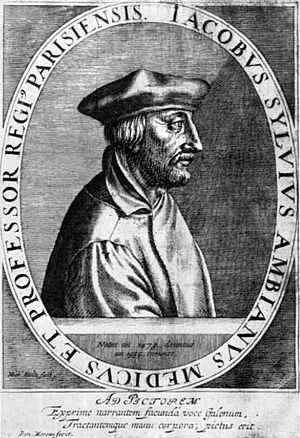Jacques Dubois facts for kids
Quick facts for kids
Jacques Dubois
|
|
|---|---|
 |
|
| Born | 1478 |
| Died | 14 January 1555 Paris
|
| Nationality | French |
| Other names | Jacobus Sylvius |
| Education | University of Montpellier (M.B., 1529; M.D., 1530) |
| Scientific career | |
| Fields | Anatomy |
| Institutions | Collège de Tréguier Collège Royal |
| Academic advisors | Hermonymus of Sparta Janus Lascaris François Vatable Jacques Lefèvre d'Étaples Franciscus Sylvius Ambianus |
| Notable students | Michael Servetus Andreas Vesalius Louis Duret |
| Influences | Hippocrates, Galen |
| Influenced | Johann Winter von Andernach |
Jacques Dubois (Latinised as Jacobus Sylvius; 1478 – 14 January 1555) was a French anatomist. Dubois was the first to describe venous valves, although their function was later discovered by William Harvey. He was the brother of Franciscus Sylvius Ambianus (François Dubois; c. 1483 – 1536), professor of humanities at the Collège de Tournai, Paris.
Contents
First years
The origins of this anatomist are vague. He was probably born in 1478 in Loeuilly, a small town near Amiens, the seventh in a family of fifteen. His father had been a weaver. At a young age he studied Ancient Greek, Hebrew and mathematics, and gradually became a leading figure in French humanism, where he was famous for his excellent knowledge of these disciplines.
Early grammar of French
Dubois was the author of the first grammar of the French language to be published in France. It was published in Paris in early 1531, less than a year after the very first French grammar, by John Palsgrave, was published in London.
From philosophy to medicine
Dubois was known for his hard work, and eloquence. He studied languages and mathematics at the University of Paris; but feeling that the rewards were inadequate, Dubois abandoned scholarship for medicine. He acquired his anatomical knowledge thanks to Jean Fagault, a famous physician of Paris and also dean of the Faculty of Medicine. While studying under Fagault, Dubois began his career as a professor with a course explaining the work of Hippocrates and Galen. These lessons concerned anatomy and were taught at the Collège de Tréguier (in Tréguier). The success of his lectures turned out to be so remarkable that the faculty of the University of Paris protested that he had not yet obtained a college degree. For this reason Sylvius went to the University of Montpellier, where he enrolled in November 1529. He received his M.B. in 1529 and his M.D. from Montpellier in 1530.
Once he obtained his degree he returned to Paris, but he was again blocked by the Faculty, which decreed that the anatomist should have obtained an M.B. from the University of Paris before returning to his lessons. On 28 June 1531 Sylvius incorporated an M.B. at Paris and was able to resume its course in anatomy. In 1550, when Vidus Vidius departed for Italy, he was appointed to succeed him as Professor of Surgery in charge of the new Collège Royal in Paris. This appointment was granted by Henry II of Valois.
Sylvius was an admirer of Galen, and interpreted the anatomical and physiological writings of that author in preference to giving demonstrations from the subject. He died on 14 January 1555 in Paris.
Sylvius as a teacher
Sylvius was not only an eloquent professor, but also a demonstration teacher. He was the first professor to teach anatomy of a human corpse, in France.
Contributions to anatomy
Sylvius made a valuable service by giving a name to the muscles, which until then had simply been referred to by numbers. He was the first anatomist to publish descriptions of satisfactory pterygoid process and the sphenoid bone and clinoid bone tear. He gave a good description of the sphenoid sinus in an adult, but denied its existence in children. Sylvius also wrote about the vertebrae, but described incorrectly the sternum.
See also
 In Spanish: Jacques Dubois para niños
In Spanish: Jacques Dubois para niños

